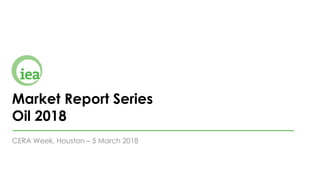
Oil 2018 - Launch Presentation
- 1. Market Report Series Oil 2018 CERA Week, Houston – 5 March 2018
- 2. © IEA 2018 Robust global oil demand growth to 2023 China and India account for almost half of world oil demand growth World oil demand growth (y-o-y change) 0.0 0.2 0.4 0.6 0.8 1.0 1.2 1.4 1.6 1.8 2017 2018 2019 2020 2021 2022 2023 mb/d Rest of the world India China
- 3. © IEA 2018 Petrochemicals drive demand growth to 2023 Petrochemical feedstocks (ethane and naphtha) responsible for 25% of global demand growth Feedstock requirements for new steam crackers 0 100 200 300 400 500 600 700 US China Russia Others kb/d Naphtha Ethane
- 4. © IEA 2018 Only limited uptick in global upstream spending Producers spend more on short cycle supply, especially US LTO. Investments in conventional fields remain depressed, but some signs of renewed interest in offshore. Global oil and gas upstream capital spending 2012-2018 -25% -26% *Preliminary based on selection of investment updates 0 100 200 300 400 500 600 700 800 900 2012 2013 2014 2015 2016 2017 2018* USD billion
- 5. © IEA 2018 -5.0 -4.0 -3.0 -2.0 -1.0 0.0 2010 2011 2012 2013 2014 2015 2016 2017 mb/d OPEC Non-OPEC Oil industry needs to replace one North Sea each year Ageing oil fields lose more than 3 mb/d per year despite slowing decline rates. Output loss from post-peak conventional crude oil fields
- 6. © IEA 2018 Booming non-OPEC supply growth reshapes world oil market… …more than covers demand growth for next three years. By 2023, non-OPEC supply grows by 5.2 mb/d. OPEC oil capacity rises only 1.2 mb/d due to Venezuelan collapse and limited increases elsewhere. Changes in global oil supply capacity 2017-2023
- 7. © IEA 2018 0 2 4 6 8 10 12 14 16 18 2010 2011 2012 2013 2014 2015 2016 2017 2018 2019 2020 2021 2022 2023 mb/d LTO Gulf of Mexico NGLs Alaska Other Higher oil prices unleash second wave of US supply Total output reaches 17 mb/d by 2023 – and could be even higher if prices rise. 0 2 4 6 8 10 12 14 16 18 2010 2011 2012 2013 2014 2015 2016 2017 2018 2019 2020 2021 2022 2023 mb/d LTO Gulf of Mexico NGLs Alaska Other
- 8. © IEA 2018 US pipeline bottlenecks ease, export capacity doubles New pipeline projects (Permian Express, EPIC) ease constraints. US export capacity rises to 4.9 mb/d by 2023. Corpus Christi solidifies position as largest US export hub. 0,0 0,1 0,2 0,3 0,4 2017 2018 2019 2020 2021 2022 2023 mb/d Expected Texas pipeline deficit 1,6 2,1 2,6 3,1 3,6 4,1 4,6 5,1 2017 2018 2019 2020 2021 2022 2023 mb/d US crude export capacity
- 9. © IEA 2018 US oil finds new markets Refiners in Asia and Europe look for suitable crude oil to produce petrochemical feedstocks and low-sulphur fuels US LTO first wave US LTO second wave Low-sulphur, low residue feedstocksLow-sulphur and petchem feedstocks
- 10. © IEA 2018 China net crude oil imports double the US in 2023 0 2 4 6 8 10 2003 2005 2007 2009 2011 2013 2015 2017 2019 2021 2023 mb/d US China India Indian imports, too, surpass the US in 2023 as shale growth reduces US import dependence. Net crude oil imports
- 11. © IEA 2018 Middle East wants to refine more oil Middle East accounts for 30% of global refining capacity growth. International downstream expansion becomes a strategic objective for the region’s NOCs. 0.0 0.5 1.0 1.5 2.0 2.5 3.0 2005-11 2011-17 2017-23 mb/d Refining capacity additions China India Middle East 0.0 0.5 1.0 1.5 2.0 2.5 3.0 2005-11 2011-17 2017-23 mb/d Middle East capacity expansion Upstream Refining
- 12. © IEA 2018 Conclusions • Robust world oil demand growth to 2023 driven mainly by petrochemicals – a key driver • Non-OPEC output growth exceeds demand increase through 2020. • US, Brazil, Canada, Norway dominate growth. New infrastructure investments relieve US export bottlenecks. • US crude finds new markets as refiners seek light, low sulphur crude to meet petrochemical demand and IMO specifications. • More upstream investment needed today to meet future demand and offset 3 mb/d of declines from mature oil fields each year. • As spare capacity cushion shrinks, supply security concerns remain critical.
- 13. © IEA 2018
